Abit AW9D-MAX: When "Beta" MAX is a good thing
by Gary Key on September 8, 2006 3:10 AM EST- Posted in
- Motherboards
Features and Layout
Abit designed a board that you will either love or hate. If nothing else this board will elicit an hours worth of conversation about the art of layout design along with providing options the customer wants at this time like an additional PCI slot. This board can be looked at as being a little ahead of its time or an experiment gone badly. After using the board for close to a week and installing it in several cases we have to say it has started to grow on us. It could be we were accepting of the minimalist design and learned to live without an additional PCI slot. Maybe in the end we just realized that the performance potential of the board merited an overlook of some design shortcomings.
Although our board is production based, the color scheme is not. Abit has decided to remove all traces of red on the board and go with all black on the PCI and PCI Express slots with a medium blue on the DIMM one and three slots. Overall, the new color scheme gives the board a very clean yet menacing look worthy of the MAX designation. The board features an excellent four-phase power regulation system, all solid aluminium electrolytic polymer capacitors, silent OTES 2 passive cooling system, and seven fan headers under the control of the Abit EQ program.
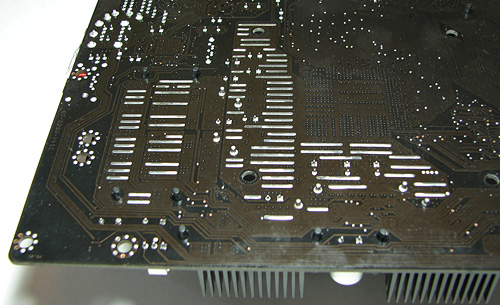
Placed on the back of the board is Abit's OC-Strips system that is designed to dissipate heat away from the board by placing small strips in strategic locations near the CPU socket and MOSFET area. Abit also integrates additional copper layers in between the PCB layers to aid in the extraction of heat from these areas. In an interesting development Abit has also placed eight blue LED diodes at various locations on the back of the board. These diodes can be configured to display differing lighting effects through a bios control panel. It is sort of like revisiting the Disco era when viewing the effects in a dark room.

The DIMM module slots' color coordination is correct for dual channel setup. The memory modules are easy to install with a full size video card placed in the first PCI Express X16 slot. The 24-pin ATX connector is conveniently located on the edge of the board in front of the number four DIMM slot. The 8-pin ATX connector is located at the edge of the first DIMM slot. The CPU fan header is located next to the 8-pin ATX plug and due to the size of the CPU area requires your heatsink/fan to be properly oriented if the cable is short.
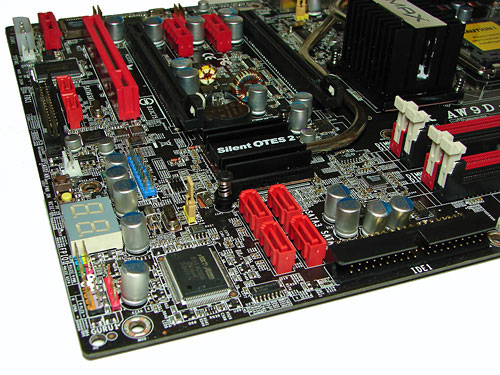
The Intel ICH7R SATA ports are conveniently located on the board's edge and in front of the single IDE port connector. Unlike other recently reviewed boards the SATA ports are not color coded for primary and secondary operation, though this is a minor concern. We found the positioning of the SATA ports to be very good when utilizing the PCI Express slots or the IDE port connector. When utilizing the second X16 PCI Express slot with a ATI X1900XTX the number one and two ports are difficult to reach.
The chassis panel, CP80P post port debug LED, power on and reset buttons, and fan header are located on the left edge of the board. The yellow clear CMOS block is a traditional jumper design and is easily accessed from its location in front of the uGuru chipset. The ICH7R chipset is passively cooled with the excellent Silent OTES 2 system and we did not notice any thermal issues during overclock testing.
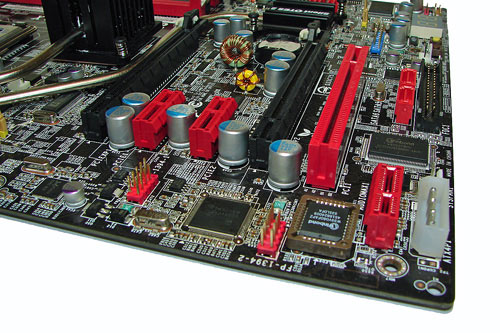
The board comes with two physical PCI Express X16 connectors, two PCI Express X1 connectors, and one PCI 2.3 compliant 32-bit connector along with a dedicated Audio Max connector. The layout of this design in our opinion does not account for the current plethora of PCI cards still in use. Considering this board is geared towards the computer enthusiast one must assume that an ATI CrossFire setup will be a likely consideration which means the single PCI slot will be physically blocked and anyone owning a sound card will be forced to use the on-board solution. A dual slot video card in the first X16 connector will also render the first PCI Express X1 connector physically useless. The black floppy drive connector and 4-pin 12V molex connector are located in inconvenient positions at the edge of the board. The first two SiL3132 SATA ports are located above the floppy drive connector.
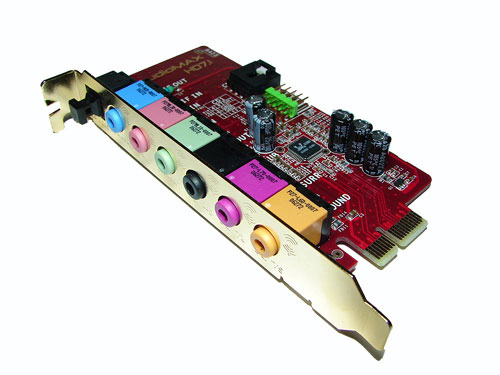
The Audio Max slot that is located next to the molex connector is designed to be used exclusively with the Audio MAX 7.1 riser card featuring the Realtek ALC-882M HD codec.
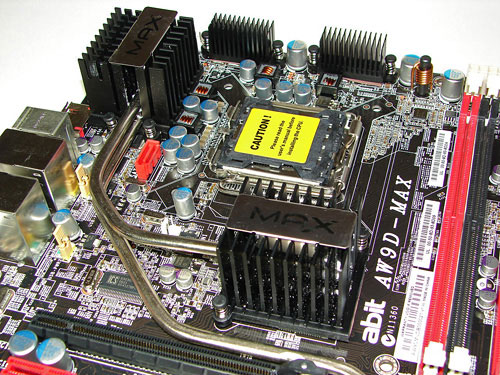
Returning to the CPU socket area, we find an ample amount of room for alternative cooling solutions. We utilized the stock Intel heatsink but also verified several aftermarket cooling systems such as the Thermaltake Big Typhoon, Zalman CNPS9500, Tuniq 120 Tower, and our Scythe Infinity would fit in this area during our tests. Due to the MCH and mosfet heatsink sizes the installation of water-cooling solutions could be problematic in certain cases, although our Cooler Master Aqua Gate system fit fine. Our only concern with water cooling is the heat generated by the MCH causes the heatsink to reach temperatures that can burn your fingers after extended use without the airflow that is normally provided by the CPU and case fans. While the system remained very stable we would highly suggest an active cooling solution for this area if you utilize water-cooling.

This I/O panel is almost legacy free and if you need a native serial or parallel port then this is not the board for you. The PS/2 mouse and keyboard ports are located to the right of the e-SATA port and fan header. The two LAN (RJ-45) ports and four USB 2.0 connectors are located next to the PS/2 connectors. The LAN (RJ-45) ports have two LED indicators representing Activity and Speed of the connection.
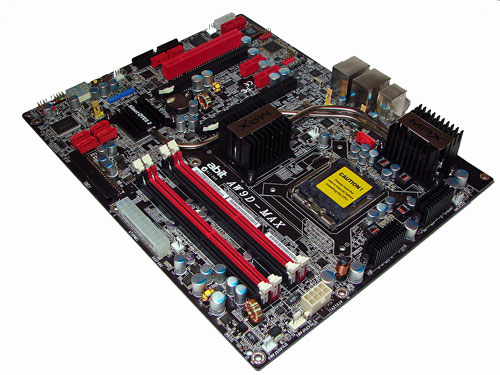 |
| Click to enlarge |
Abit designed a board that you will either love or hate. If nothing else this board will elicit an hours worth of conversation about the art of layout design along with providing options the customer wants at this time like an additional PCI slot. This board can be looked at as being a little ahead of its time or an experiment gone badly. After using the board for close to a week and installing it in several cases we have to say it has started to grow on us. It could be we were accepting of the minimalist design and learned to live without an additional PCI slot. Maybe in the end we just realized that the performance potential of the board merited an overlook of some design shortcomings.
Although our board is production based, the color scheme is not. Abit has decided to remove all traces of red on the board and go with all black on the PCI and PCI Express slots with a medium blue on the DIMM one and three slots. Overall, the new color scheme gives the board a very clean yet menacing look worthy of the MAX designation. The board features an excellent four-phase power regulation system, all solid aluminium electrolytic polymer capacitors, silent OTES 2 passive cooling system, and seven fan headers under the control of the Abit EQ program.

Placed on the back of the board is Abit's OC-Strips system that is designed to dissipate heat away from the board by placing small strips in strategic locations near the CPU socket and MOSFET area. Abit also integrates additional copper layers in between the PCB layers to aid in the extraction of heat from these areas. In an interesting development Abit has also placed eight blue LED diodes at various locations on the back of the board. These diodes can be configured to display differing lighting effects through a bios control panel. It is sort of like revisiting the Disco era when viewing the effects in a dark room.

The DIMM module slots' color coordination is correct for dual channel setup. The memory modules are easy to install with a full size video card placed in the first PCI Express X16 slot. The 24-pin ATX connector is conveniently located on the edge of the board in front of the number four DIMM slot. The 8-pin ATX connector is located at the edge of the first DIMM slot. The CPU fan header is located next to the 8-pin ATX plug and due to the size of the CPU area requires your heatsink/fan to be properly oriented if the cable is short.

The Intel ICH7R SATA ports are conveniently located on the board's edge and in front of the single IDE port connector. Unlike other recently reviewed boards the SATA ports are not color coded for primary and secondary operation, though this is a minor concern. We found the positioning of the SATA ports to be very good when utilizing the PCI Express slots or the IDE port connector. When utilizing the second X16 PCI Express slot with a ATI X1900XTX the number one and two ports are difficult to reach.
The chassis panel, CP80P post port debug LED, power on and reset buttons, and fan header are located on the left edge of the board. The yellow clear CMOS block is a traditional jumper design and is easily accessed from its location in front of the uGuru chipset. The ICH7R chipset is passively cooled with the excellent Silent OTES 2 system and we did not notice any thermal issues during overclock testing.

The board comes with two physical PCI Express X16 connectors, two PCI Express X1 connectors, and one PCI 2.3 compliant 32-bit connector along with a dedicated Audio Max connector. The layout of this design in our opinion does not account for the current plethora of PCI cards still in use. Considering this board is geared towards the computer enthusiast one must assume that an ATI CrossFire setup will be a likely consideration which means the single PCI slot will be physically blocked and anyone owning a sound card will be forced to use the on-board solution. A dual slot video card in the first X16 connector will also render the first PCI Express X1 connector physically useless. The black floppy drive connector and 4-pin 12V molex connector are located in inconvenient positions at the edge of the board. The first two SiL3132 SATA ports are located above the floppy drive connector.

The Audio Max slot that is located next to the molex connector is designed to be used exclusively with the Audio MAX 7.1 riser card featuring the Realtek ALC-882M HD codec.

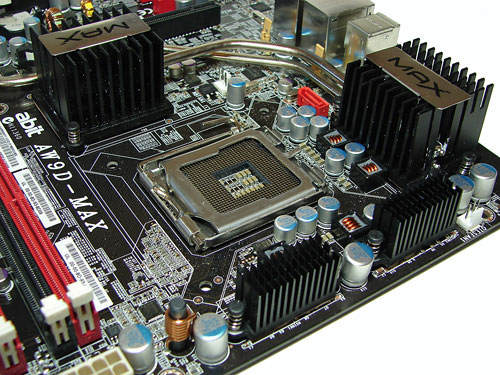 |
| Click to enlarge |
Returning to the CPU socket area, we find an ample amount of room for alternative cooling solutions. We utilized the stock Intel heatsink but also verified several aftermarket cooling systems such as the Thermaltake Big Typhoon, Zalman CNPS9500, Tuniq 120 Tower, and our Scythe Infinity would fit in this area during our tests. Due to the MCH and mosfet heatsink sizes the installation of water-cooling solutions could be problematic in certain cases, although our Cooler Master Aqua Gate system fit fine. Our only concern with water cooling is the heat generated by the MCH causes the heatsink to reach temperatures that can burn your fingers after extended use without the airflow that is normally provided by the CPU and case fans. While the system remained very stable we would highly suggest an active cooling solution for this area if you utilize water-cooling.

This I/O panel is almost legacy free and if you need a native serial or parallel port then this is not the board for you. The PS/2 mouse and keyboard ports are located to the right of the e-SATA port and fan header. The two LAN (RJ-45) ports and four USB 2.0 connectors are located next to the PS/2 connectors. The LAN (RJ-45) ports have two LED indicators representing Activity and Speed of the connection.










56 Comments
View All Comments
Jedi2155 - Friday, September 8, 2006 - link
Oh heck yea! I thought I was going to have to go with Asus P5B deluxe board mainly due to the color scheme as I'm a bigger fan of Black & Blue than Black & Red. Too bad for all those other people who prefer red tho.wolf550e - Friday, September 8, 2006 - link
How much is Scyhte paying you?Madellga - Friday, September 8, 2006 - link
Actually his review is very neutral and not a PR stunt.This space is to discuss the review itself and the product there.
If you want to make such comments I suggest paging him, instead of writing here on the open.
Gary Key - Friday, September 8, 2006 - link
Actually I paid NewEgg $51.99 for the pleasure of using the Scythe Infinity. :) Scythe does not advertise with us and the picture was published based upon numerous reader requests wanting to know how the larger heatsinks fit on the boards. I still love and use the Tuniq 120 but until they are readily available again my current air cooling favorite is the Infinity. Just in case it comes up, the E6600 was also bought from NewEgg and is not supplied by Intel.
DigitalFreak - Friday, September 8, 2006 - link
LOL! First time I've ever heard a motherboard described as "menacing".
mostlyprudent - Friday, September 8, 2006 - link
I am very pleased to see Abit producing a strong board again. Two of my older systems are still running with Abit boards (4 years old and 2.5 years old) with no issues. I am still deciding, but the PCI slot issue is a tough pill to swallow.BTW, there is a type-o in the last paragraph on page 3 "Although this 'typcially' worked..."
GoatMonkey - Friday, September 8, 2006 - link
I used to be a big Abit fan. I bought 5 Abit motherboard for myself over the years, and built at least 4 other systems for friends with Abit motherboards. Unfortunately, over half of them failed after several months of use. Abit really needs a good warranty and some good testimonial of quality to get me back.yyrkoon - Friday, September 8, 2006 - link
ABIT has a decent warranty policy, the only problem is that they exchange 're-certified' boards for your new one.We've had to deal with ABITs RMA a couple of times in the last two years, and while they did replace the boards, the process was slow, and again, they replace it with a re-certified board. However, it turned out it wasnt the motherboard that was bad at all, but a ATI videocard (pre-PCIE, and additional card power), that was drawing too much power from the AGP slot.
ABIT forums, while not owned or paricipated by any ABIT workers (that I know of), is second to none. If you cannot find someone on ABITs forums to help with an issue, then said issue is rare, or hard to trace.
I'm finding that more, and more, that motherboards dont really go bad (short term), but often 'broken' motherboards are configured improperly by the user, that has limited experience with that brand, or a user that really hasnt a clue how to properly setup a motherboard. This doesnt include the rare chance of a dead out of the box motherboard, or the random hard to troubleshoot other than motherboard issues, and I've recently experience the latter here myself (an Asrock board that would lock up within three days, no BSoD, and nothing standard fixed the problem).
The main reason why I like ABIT, is that usually ABIT boards have stability that is second to none, and they perform very well.
granulated - Friday, September 8, 2006 - link
I know that the Scyhte Infinity is approx 12cm x 12cm but blimey !It's looks massive !
yyrkoon - Friday, September 8, 2006 - link
Gary, was wondering if yo ucould confirm if ABIT boards with eSATA, and a SIL 3132 controller will in fact work with a SATA port multiplier. From all the researching Ive done for the last year or so would indicate so, but I would like ot make sure before investing loads of cash in an external RAID 5 array, only to have it not work.